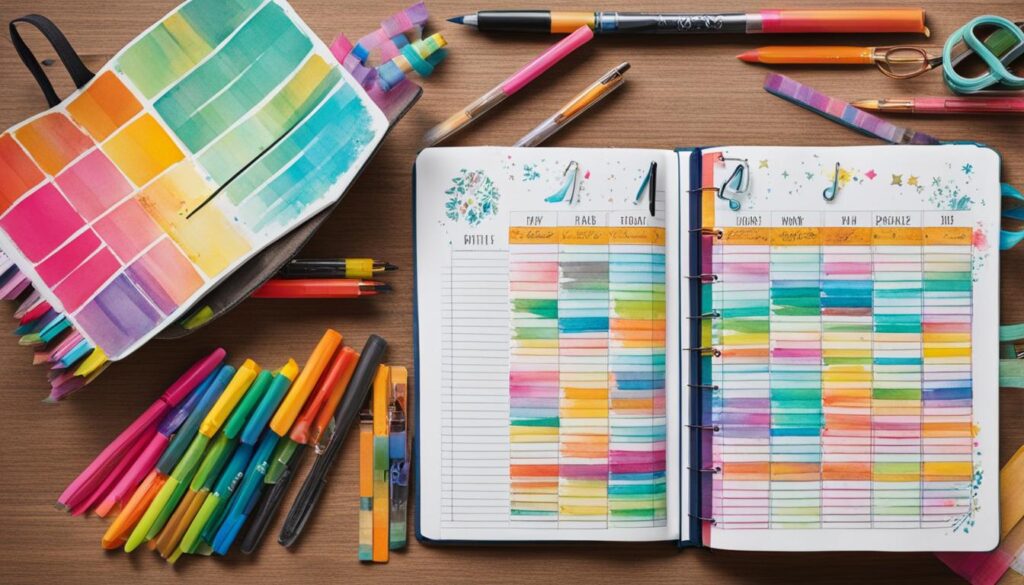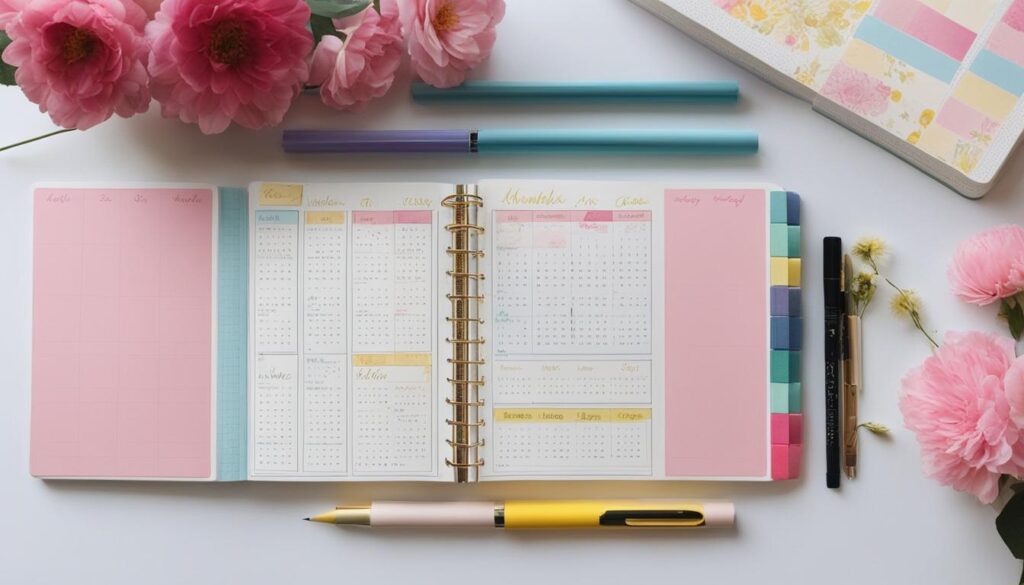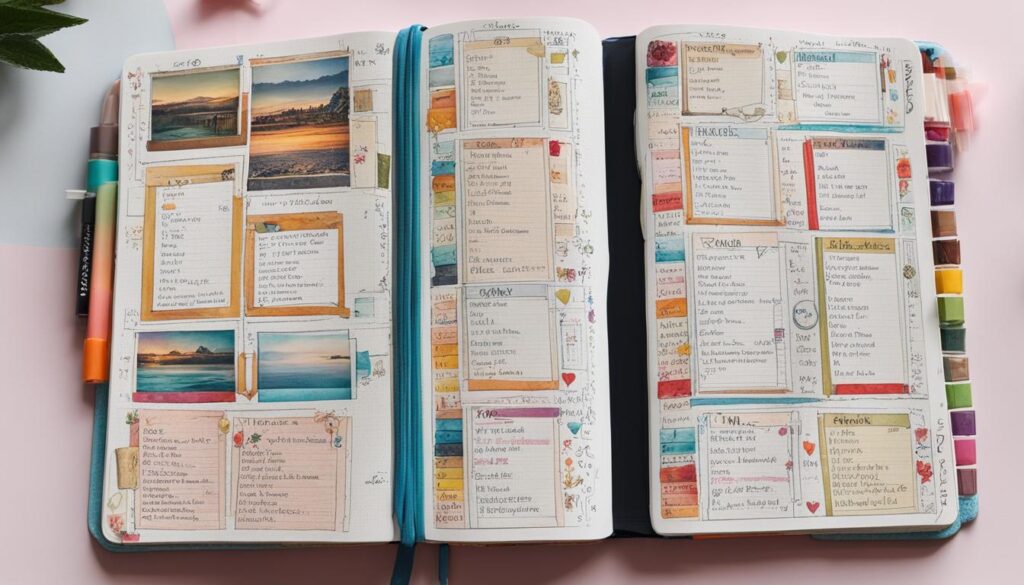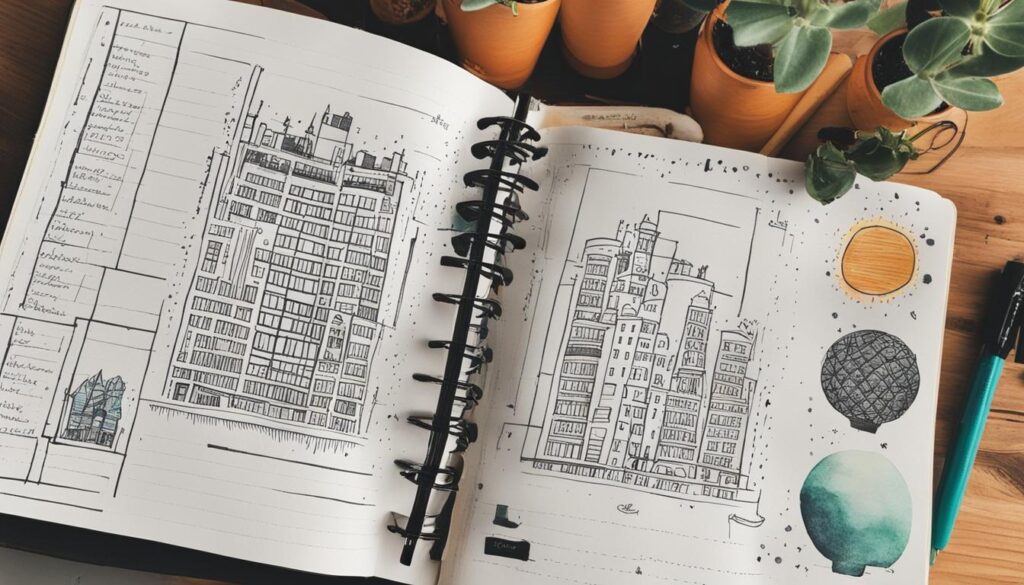Our website is supported by our readers. We sometimes earn affiliate commissions when you click through the affiliate links on our website at no extra cost to you.
Welcome to your comprehensive guide on how to achieve the perfect bullet journal aesthetic. Whether you’re a seasoned bullet journal enthusiast or just starting out, this guide will provide you with all the inspiration, tips, and ideas you need to create a visually stunning and functional bullet journal.
For those unfamiliar with the bullet journal system, it’s a highly customizable planning system that allows you to organize your tasks, events, and thoughts in a way that suits your unique style and needs. With key elements such as the index, monthly log, daily log, collections, and future log, you have the freedom to design your bullet journal to reflect your personality and preferences.
Are you searching for some bullet journal inspiration? Look no further! In this guide, we’ll explore various themes, layouts, and creative techniques that will help you elevate your bullet journal’s aesthetic to the next level. Get ready to unleash your creativity and make your bullet journal a true masterpiece.
Key Takeaways:
- Discover the key elements of a bullet journal, including the index, monthly log, daily log, collections, and future log.
- Learn about the founder of the bullet journal system, Ryder Carroll, and his vision for a customized planning system.
- Explore recommended bullet journal supplies that can enhance your journaling experience, such as the Leuchtturm1917 notebook and Faber-Castell Pitt Artist Pens.
- Understand the essential pages in a bullet journal, including the index, monthly log, weekly spread, and daily spread.
- Learn how to create collections in your bullet journal for tracking habits, recording memories, and expressing gratitude.
What is a Bullet Journal?
The bullet journal, created by Ryder Carroll, is a highly customizable planning system that allows you to organize your tasks, events, and thoughts in a coherent and personalized way. It serves as a tool for productivity, organization, and creativity. With the bullet journal, you have the freedom to design your own layouts, trackers, and collections to suit your needs and preferences.
The key elements of a bullet journal include the index, monthly log, daily log, collections, and future log. The index acts as a table of contents, helping you easily locate specific pages. The monthly log helps you plan and track events and tasks for the month ahead, while the daily log allows you to jot down tasks, events, and notes for each day. Collections are specific topic pages that help you organize and track various aspects of your life, such as habits, goals, and memories. The future log is where you can plan and schedule events and tasks for the future.

The bullet journal is a flexible and adaptable system that can be tailored to your individual needs. Whether you prefer a minimalist approach with simple layouts and clean lines, or an artsy style with colorful illustrations and hand-lettering, the choice is yours. The beauty of the bullet journal lies in its ability to blend functionality with creativity, allowing you to create a journal that is both practical and visually appealing.
Overall, the bullet journal is more than just a planner – it is a planning system that can help you stay organized, track your progress, and unleash your creativity.
Getting Started with Bullet Journaling
If you’re ready to jump into the world of bullet journaling, there are a few supplies that can help you get started on the right foot. While all you really need is a blank notebook and a pen, investing in some quality tools can enhance your bullet journaling experience.
A highly recommended notebook for bullet journaling is the Leuchtturm1917. Known for its high-quality paper and variety of color options, this notebook provides a great base for your bullet journal. Its dotted grid pages make it easy to create clean and organized layouts, and its sturdy binding ensures that your journal will last.

When it comes to pens, the Faber-Castell Pitt Artist Pens are a popular choice among bullet journal enthusiasts. These pens offer smooth and consistent ink flow, allowing you to create clean and precise lines. They are available in various tip sizes and colors, giving you the flexibility to add detail or highlight important tasks in your journal.

It’s important to remember that while these supplies can enhance your bullet journaling experience, they are not necessary to get started. The most important thing is to find tools that you feel comfortable using and that fit your personal style of journaling. Now that you have your supplies, let’s dive into the wonderful world of bullet journaling to create a journal that truly reflects your unique style and personality.

Tips for Starting Your Bullet Journal Journey
- Start with a notebook and pen that you enjoy using.
- Choose a layout style that fits your needs and preferences.
- Experiment with different collections and trackers to find what works best for you.
- Don’t be afraid to make mistakes or change things up as you go along.
- Take inspiration from others, but don’t compare your journal to theirs.
- Most importantly, have fun and enjoy the process of creating your bullet journal!
Essential Pages in a Bullet Journal
When it comes to creating a bullet journal, there are a few essential pages that you’ll want to include. These pages serve as the foundation for your journal and help you stay organized and focused. Let’s take a closer look at each of these essential pages.
Index
The index is like the table of contents for your bullet journal. It allows you to quickly find specific pages by providing a reference for the different sections and collections in your journal. As you add new pages, simply update your index to keep track of where everything is located.
Monthly Log
The monthly log helps you plan and track events and tasks for the month ahead. It typically includes a calendar grid where you can jot down important dates, appointments, and deadlines. You can also include a section for goals and priorities for the month. The monthly log provides a high-level overview of your schedule and helps you stay on top of your commitments.
Weekly Spread
The weekly spread allows you to visualize your week at a glance. It typically includes a section for each day of the week where you can write down tasks, appointments, and other important events. Some bullet journal enthusiasts also include space for meal planning, habit tracking, or gratitude practice within their weekly spreads. This page is a great way to plan your week and ensure that you’re staying focused and productive.
Daily Spread
The daily spread is where you can jot down tasks, events, and notes for each day. It provides a detailed view of your daily schedule and allows you to prioritize your tasks. Some people like to include additional sections in their daily spreads, such as a gratitude log, a habit tracker, or a space for reflection. This page is where you can capture the details of your day and keep track of everything that needs to be done.

These essential pages form the backbone of a bullet journal and provide a solid framework for staying organized and productive. However, it’s important to remember that your bullet journal is highly customizable, and you can add or modify pages to fit your specific needs and preferences. Experiment with different layouts and designs to create a journal that is both functional and aesthetically pleasing.
Creating Collections in Your Bullet Journal
Creating collections in your bullet journal is a great way to organize and track various aspects of your life. Whether you want to monitor your habits, jot down memorable moments, or express gratitude, collections are the perfect tool. Here are some popular collections that you can include in your bullet journal:
- Trackers: Trackers are a valuable tool for monitoring habits, goals, and other important metrics. Whether you want to keep track of your exercise routine, water intake, or daily mood, trackers help you stay accountable and motivated.
- Memories log: A memories log is a collection where you can record special moments and experiences. Whether it’s a funny quote, a meaningful conversation, or a beautiful sunset, jotting down these memories allows you to revisit and cherish them in the future.
- Gratitude log: Expressing gratitude is a powerful way to cultivate positivity and mindfulness. A gratitude log allows you to reflect on the things you appreciate in life, whether big or small. It’s a simple practice that can bring a sense of happiness and contentment.
Of course, these are just a few examples of collections you can create in your bullet journal. The beauty of bullet journaling is that you can customize and expand upon these collections to suit your specific interests and goals. Don’t be afraid to get creative and experiment with different layouts, designs, and themes. Your bullet journal is a reflection of you, so make it uniquely yours.

Table: Examples of Bullet Journal Collections
| Collection | Description |
|---|---|
| Trackers | Monitor habits, goals, and important metrics |
| Memories log | Jot down special moments and experiences |
| Gratitude log | Express gratitude for the things you appreciate |
Bullet Journal Minimalist vs. Artsy Styles
When it comes to bullet journaling, there are two main styles that enthusiasts tend to gravitate towards: the minimalist style and the artsy style. Each style offers its own unique approach to organizing and expressing creativity within your bullet journal.
The minimalist style focuses on simplicity and functionality. It utilizes clean lines, minimal decoration, and a more streamlined layout. This style is ideal for those who prefer a more minimalist aesthetic and want their bullet journal to be a practical tool for organization and productivity. With the minimalist style, the emphasis is placed on the content rather than elaborate designs.
On the other hand, the artsy style of bullet journaling is all about creativity and self-expression. This style often incorporates intricate designs, hand-lettering, and colorful illustrations. It allows you to showcase your artistic skills and add a personal touch to your journal pages. The artsy style is perfect for those who enjoy the process of creating visually stunning layouts and want their bullet journal to be a creative outlet.

Whether you choose the minimalist or artsy style, it’s important to remember that there are no hard rules when it comes to bullet journaling. You have the freedom to customize your journal to suit your own preferences and needs. You can mix elements from both styles or create your own unique style that reflects your personality. The key is to experiment and find what works best for you.
Ultimately, the choice between the minimalist and artsy styles comes down to personal preference. Some people find peace and productivity in the simplicity of the minimalist style, while others find joy and inspiration in the artistic expression of the artsy style. Whichever style you choose, bullet journaling is a versatile and adaptable system that can be tailored to fit your individual needs and goals.
Tips for Beginners in Bullet Journaling
If you’re new to bullet journaling, here are a few essential tips to help you get started and make the most of this planning system.
First and foremost, don’t overdo it. It can be tempting to dive into bullet journaling with elaborate spreads and collections, but remember to start small. Begin with simple layouts and gradually add more elements as you become comfortable with the system. This will prevent you from feeling overwhelmed and allow you to build confidence in your bullet journaling skills.
Secondly, give it time. Like any new habit or system, bullet journaling takes time to get used to. It may take a few weeks or even months to find your rhythm and develop a routine that works for you. Be patient and allow yourself the space to experiment and adjust as needed.
Lastly, don’t compare your bullet journal to others. Each bullet journal is unique and should reflect your own style and preferences. While it can be inspiring to see what others create, remember that your journal is a reflection of you. Embrace your individuality and focus on making your bullet journal a space that brings you joy and helps you stay organized.



